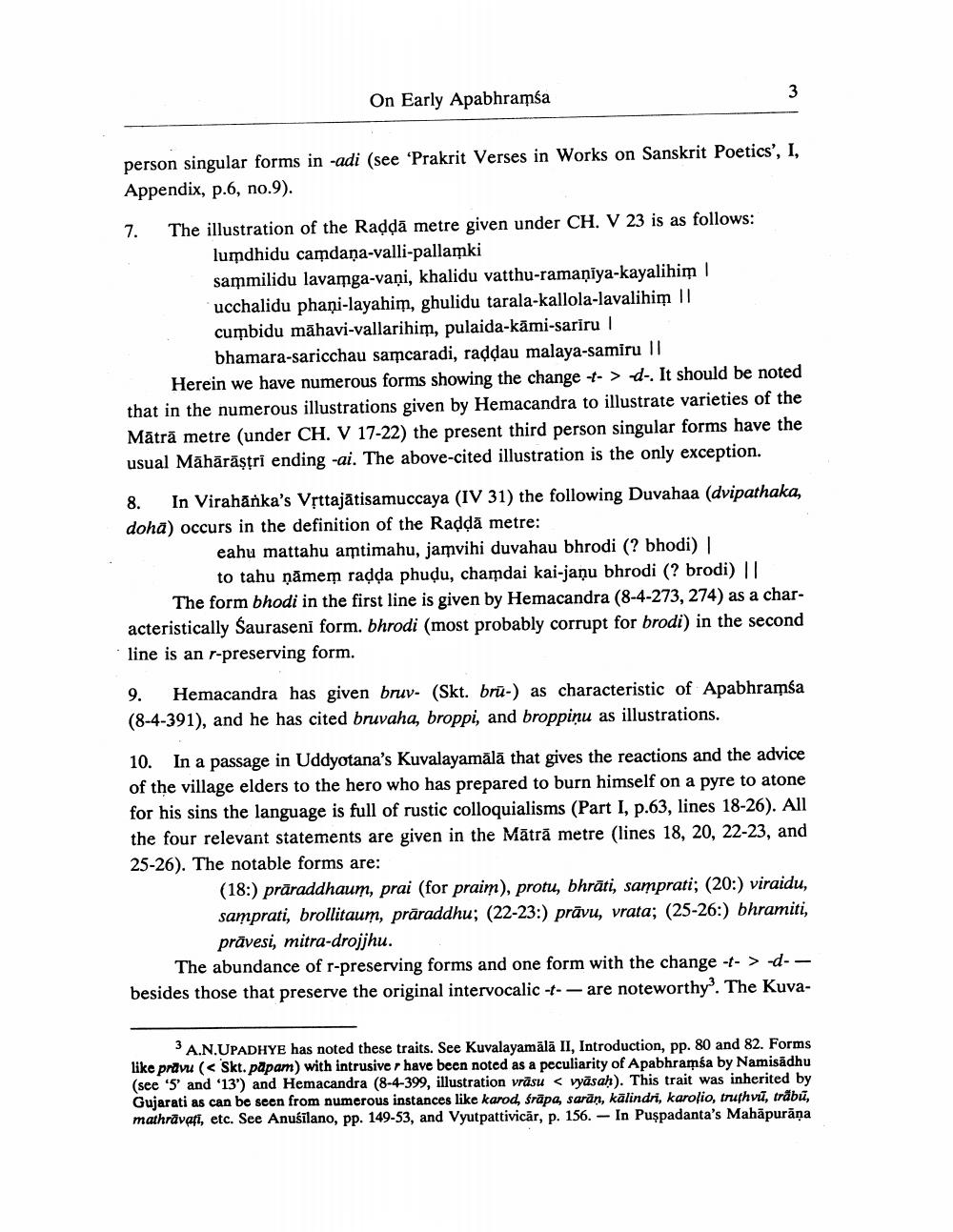Book Title: On Early Apbhramsa Author(s): H C Bhayani Publisher: H C Bhayani View full book textPage 3
________________ On Early Apabhramsa person singular forms in -adi (see 'Prakrit Verses in Works on Sanskrit Poetics', I, Appendix, p.6, no.9). 3 7. The illustration of the Radḍā metre given under CH. V 23 is as follows: lumdhidu camdana-valli-pallamki sammilidu lavamga-vani, khalidu vatthu-ramaniya-kayalihim I ucchalidu phanņi-layahim, ghulidu tarala-kallola-lavalihim || cumbidu mähavi-vallarihim, pulaida-kami-sariru I bhamara-saricchau samcaradi, raddau malaya-samiru II Herein we have numerous forms showing the change -t->d-. It should be noted that in the numerous illustrations given by Hemacandra to illustrate varieties of the Mäträ metre (under CH. V 17-22) the present third person singular forms have the usual Mähäräştri ending -ai. The above-cited illustration is the only exception. 8. In Virahanka's Vṛttajatisamuccaya (IV 31) the following Duvahaa (dvipathaka, doha) occurs in the definition of the Radḍā metre: eahu mattahu amtimahu, jamvihi duvahau bhrodi (? bhodi) | to tahu namem radda phudu, chamdai kai-jaņu bhrodi (? brodi) || The form bhodi in the first line is given by Hemacandra (8-4-273, 274) as a characteristically Sauraseni form. bhrodi (most probably corrupt for brodi) in the second line is an -preserving form. 9. Hemacandra has given bruv (Skt. bra-) as characteristic of Apabhramsa (8-4-391), and he has cited bruvaha, broppi, and broppinu as illustrations. 10. In a passage in Uddyotana's Kuvalayamāla that gives the reactions and the advice of the village elders to the hero who has prepared to burn himself on a pyre to atone for his sins the language is full of rustic colloquialisms (Part I, p.63, lines 18-26). All the four relevant statements are given in the Mäträ metre (lines 18, 20, 22-23, and 25-26). The notable forms are: (18:) praraddhaum, prai (for praim), protu, bhrāti, samprati; (20:) viraidu, samprati, brollitaum, praraddhu; (22-23:) pravu, vrata; (25-26:) bhramiti, prăvesi, mitra-drojjhu. The abundance of r-preserving forms and one form with the change -t- > -d-besides those that preserve the original intervocalic -t--are noteworthy3. The Kuva 3 A.N.UPADHYE has noted these traits. See Kuvalayamālā II, Introduction, pp. 80 and 82. Forms like pravu (< Skt. papam) with intrusiver have been noted as a peculiarity of Apabhramsa by Namisādhu (see '5' and '13') and Hemacandra (8-4-399, illustration vräsu < vyasah). This trait was inherited by Gujarati as can be seen from numerous instances like karod, śräpa, saran, kalindri, karolio, truthvi, träbū, mathravati, etc. See Anušilano, pp. 149-53, and Vyutpattivicar, p. 156. - In Puspadanta's MahāpurāņaPage Navigation
1 2 3 4 5 6 7
